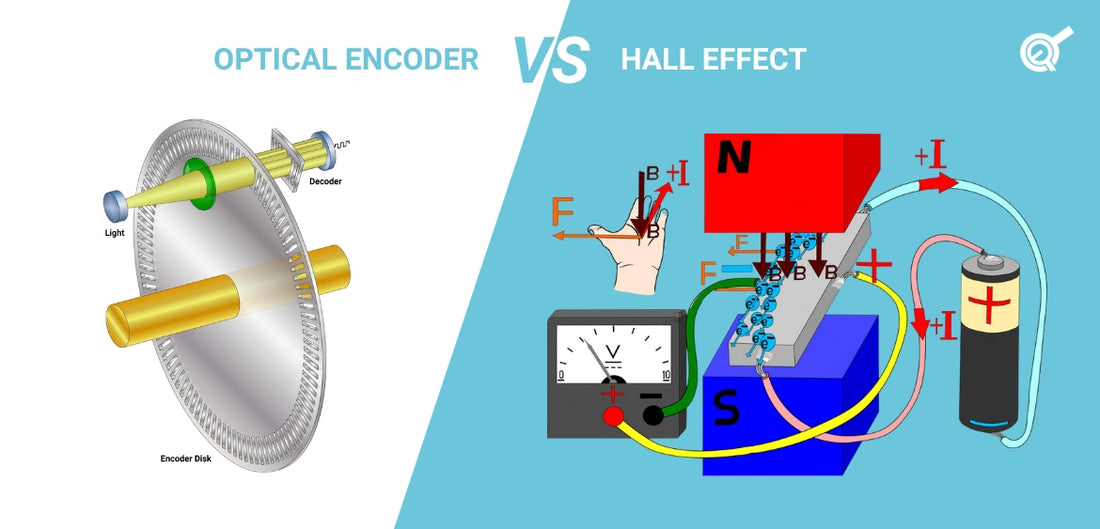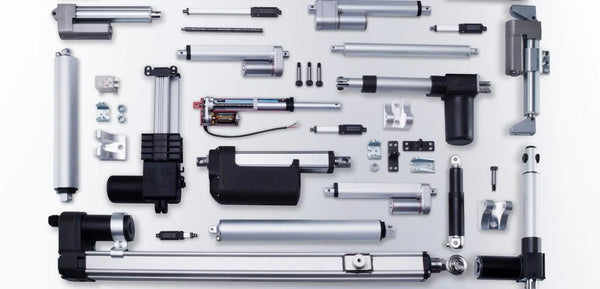Correctement mis en œuvre, le retour de position permet à plusieurs actionneurs de se déplacer simultanément, d'utiliser des positions mémorisées prédéfinies et de se déplacer avec une précision accrue. Les codeurs optiques et les capteurs à effet Hall sont tous deux populaires pour lire le retour de position d'un moteur avec une bonne précision. Cependant, chaque option de retour offre des avantages différents, favorisant certaines applications plus que d'autres. Cet article compare les aspects importants des codeurs optiques et des capteurs à effet Hall, tels que leur fonctionnement, leurs applications courantes et leurs avantages et inconvénients, afin de vous aider à déterminer l'option de retour la mieux adaptée à vos besoins.
Exploration des codeurs optiques : fonctions et applications

Les codeurs optiques sont des dispositifs de rétroaction permettant de mesurer la position d'un arbre moteur. Ils utilisent des photocapteurs pour détecter les faisceaux lumineux traversant les fentes d'un disque rotatif interne. Un photocapteur fait office de récepteur et génère une impulsion électrique à chaque passage de lumière à travers les marques transparentes d'une fente. Cette impulsion, au fil du temps, crée une forme d'onde carrée lors du comptage de la chaîne d'impulsions.

En comptant ces impulsions, un contrôleur externe distinct peut suivre des informations telles que la position actuelle du moteur, sa vitesse et son nombre de tours. Cela fournit un retour d'information précis, utilisable pour contrôler le mouvement d'un moteur entraînant un actionneur linéaire . Compte tenu de leur très grande précision et de leur vitesse, les codeurs optiques sont des dispositifs de retour d'information très prisés dans des cas d'utilisation tels que :
- systèmes de tomodensitométrie
- Équipement de laboratoire
- Dispositifs médicaux
- Spectromètres
- Centrifugeuses

Avantages et limites des codeurs optiques
Avantages
- Haute résolution : les codeurs optiques peuvent fournir une très haute résolution, permettant une détection de position précise.
- Précision : Les codeurs optiques offrent une très grande précision dans la détection de position, ce qui les rend adaptés aux applications nécessitant des mesures précises.
- Aucun contact : la détection basée sur la lumière ne nécessite pas de contact physique entre l'encodeur et l'élément de détection, ce qui réduit l'usure et augmente la durée de vie des encodeurs optiques.
- Haute vitesse : les codeurs optiques peuvent fonctionner à des vitesses élevées, ce qui en fait des choix idéaux pour les applications qui nécessitent une détection de position rapide sans compromettre la précision.
Inconvénients
- Sensible aux facteurs environnementaux : la « ligne de visée » des sources lumineuses des encodeurs optiques peut être affectée par la poussière, la saleté et d’autres facteurs environnementaux avant d’atteindre le récepteur interne, ce qui peut réduire leur précision et leur exactitude .
- Installation complexe : les encodeurs optiques nécessitent un alignement et une installation minutieux pour garantir des lectures précises, ce qui peut être un processus long et difficile.
- Fragilité : Comparés à d'autres types de mécanismes de rétroaction, les codeurs optiques sont conçus avec des disques de verre minces et des plastiques qui sont plus fragiles et susceptibles d'être endommagés lorsqu'ils sont soumis à des contraintes mécaniques ou à des vibrations.
Exploration des capteurs à effet Hall : principes et utilisations

La théorie de l'effet Hall, inventée par Edwin Hall, stipule que lorsqu'un champ magnétique est appliqué perpendiculairement au flux de courant électrique dans un conducteur, une différence de tension est induite. Cette tension permet de détecter la proximité d'un aimant par un capteur à effet Hall. En fixant un aimant à l'arbre rotatif d'un moteur, les capteurs à effet Hall peuvent détecter si l'arbre leur est parallèle. À l'aide d'un petit circuit imprimé, cette information peut être transmise sous forme d'onde carrée, comme le font les codeurs optiques.

Les circuits imprimés à effet Hall sont souvent équipés de deux capteurs, ce qui produit une sortie en quadrature où deux signaux montent et descendent pendant la rotation du moteur électrique, avec un déphasage de 90°. En comptant ces impulsions et en identifiant celle qui arrive en premier, vous pouvez déterminer le sens de rotation du moteur. La fréquence de ces impulsions varie selon notre gamme d' actionneurs linéaires électriques sur mesure. Cependant, notre PA-04-HS offre un retour d'information par capteur à effet Hall standard. Leur bonne précision et leur robustesse en font des capteurs à effet Hall très prisés pour des applications telles que :
- Applications automobiles
- Bureaux ergonomiques pour la maison et le bureau
- Suivi solaire et énergies renouvelables
- Applications marines
- Système de levage industriel/lourd

Forces et faiblesses des capteurs à effet Hall
Avantages
- Détection sans contact : les capteurs à effet Hall ne nécessitent pas non plus de contact physique avec leur élément de détection à effet Hall, ce qui réduit l'usure et augmente la durée de vie de l'appareil.
- Robustesse : les capteurs à effet Hall sont plus robustes et résistants aux facteurs environnementaux tels que la poussière, la saleté et les vibrations, augmentant ainsi leur fiabilité globale dans les applications avec des conditions de fonctionnement difficiles.
- Installation simple : les capteurs à effet Hall sont relativement faciles à installer et nécessitent moins d'alignement que les codeurs optiques.
- Coût inférieur : les capteurs à effet Hall ont généralement un prix plus abordable que les encodeurs optiques.
Inconvénients
- Résolution inférieure : les capteurs à effet Hall ont généralement une résolution inférieure à celle des codeurs optiques, ce qui peut entraîner des limitations quant à leur adéquation aux applications nécessitant une très haute précision.
- Vitesse limitée : les capteurs à effet Hall ont davantage de limitations en termes de vitesse maximale à laquelle ils peuvent détecter avec précision la position.
- Interférence magnétique : les aimants internes des capteurs à effet Hall peuvent être affectés par des interférences magnétiques provenant de l'extérieur, ce qui a un impact sur la précision et la fiabilité du retour d'information dans certains environnements.
- Sensibilité à la température : les propriétés magnétiques des capteurs à effet Hall peuvent être affectées par les variations de température, ce qui peut nécessiter une compensation ou un étalonnage supplémentaire dans les applications avec de grands changements de plage de température.
EN RÉSUMÉ
Les codeurs optiques et les capteurs à effet Hall sont des choix populaires pour la lecture de la rétroaction de position. Cependant, il est important de connaître leurs différences, notamment leurs avantages et leurs inconvénients. Lors du choix entre codeurs optiques et capteurs à effet Hall , il est important de trouver le bon équilibre entre précision, durabilité, complexité et prix.
En tant que l'un des principaux fournisseurs d'actionneurs linéaires électriques, Progressive Automations offre une flexibilité, une qualité, un support et une expérience terrain de pointe pour répondre à tous vos besoins. Pour toute question concernant nos offres, n'hésitez pas à nous contacter ! Experts dans notre domaine, nous souhaitons vous garantir les solutions les plus adaptées à votre application.
sales@progressiveautomations.com | 1-800-676-6123








